WW II
Aerial Combat
Fast Play Rules for Students
< Home
>
by Mic McGoldrick and Matt
Fritz
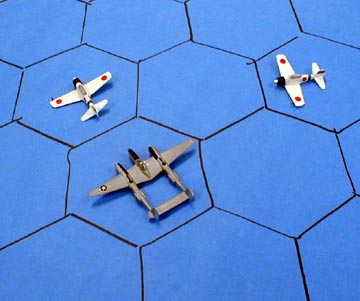 Historical
Background: At the start
of World War II some pilots were still flying obsolete bi-planes.
By the end of the war Germany had entered the jet age. The Luftwaffe
was an essential element in the early success of the German blitzkrieg.
The Battle of Britain was fought in the skies. The Allies had
to gain air superiority before they could launch the D-Day invasion.
German targets were bombed night and day. Eventually the threat
of attack from the air was a major obstacle to German operations.
In the Pacific the Japanese aircraft carriers dominated the seas.
Only after four Japanese carriers (and many veteran pilots) were
destroyed at the Battle of Midway did the United States turn the
tables. Thereafter each island captured meant a new airfield to
extend the range of US air power. The desperate Japanese resorted
to kamikaze attacks. In the end, the war was ended with atomic
bombs delivered by bombers.
Historical
Background: At the start
of World War II some pilots were still flying obsolete bi-planes.
By the end of the war Germany had entered the jet age. The Luftwaffe
was an essential element in the early success of the German blitzkrieg.
The Battle of Britain was fought in the skies. The Allies had
to gain air superiority before they could launch the D-Day invasion.
German targets were bombed night and day. Eventually the threat
of attack from the air was a major obstacle to German operations.
In the Pacific the Japanese aircraft carriers dominated the seas.
Only after four Japanese carriers (and many veteran pilots) were
destroyed at the Battle of Midway did the United States turn the
tables. Thereafter each island captured meant a new airfield to
extend the range of US air power. The desperate Japanese resorted
to kamikaze attacks. In the end, the war was ended with atomic
bombs delivered by bombers.
Design Note: The rules for WW II air combat were developed
by Mic McGoldrick. This game is a variant of the WW
I air combat rules. I made some Pilot Licenses and paper plane
models to go with Mic's maneuver cards. The only difference between
the WW II rules and the WW I rules are the maneuver cards, so
if you are already familiar with the old rules you can skip to
that section and start playing. Mic has also developed some optional
rules that model the different attributes of the fighters. They
add flavor to the game.
Battle 1: The combat was fierce as British and American pilots
tried to take control of the skies from their German enemies.
The Germans managed to get the better of the fight (22 - 18).
Only one German pilot managed to reach 5 victories. The top
allied pilot (4 victories) was an American with a habit of flying
his P-51 Mustang directly at his opponents, blazing away with
his guns at point blank range. It was a dangerous tactic that
terrified the Germans and often left his own plane a smoking,
bullet riddled ruin.
Battle 2: The Japanese had controlled the skies over the
Pacific for so long that they had begun to take it for granted.
Things changed quickly. Flying their P-38 Lightnings with reckless
abandon the American pilots took an early lead and never looked
back. When the dust settled they had scored an impressive victory
(31-23), and three pilots had become aces.
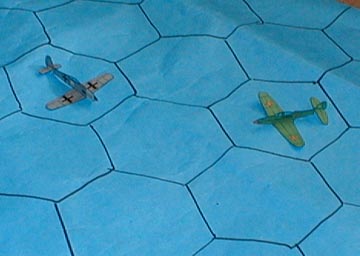 Rules
Rules
The models: Plastic model planes are readily available
in 1/72 and 1/144 scale. The 1/144 models are cheap, and just
the right size. They are also very easy for the students to build.
You can find die-cast planes from manufacturers like Corgi and
Model Power. Here are some simple paper airplane models you and
print and use.
Additional free paper airplanes are available from a lot of web
sites, just look around. Paperworlds.com
and FreePaperToys.com
is a good place to start a search. You can also purchase origami
airplane models for at Fiddler's
Green and Papertigerarmaments.com.
Each Student gets:
- 1 airplane model
- 1 deck of maneuver cards
- 1 Pilot License (laminated)
- 1 dry erase marker
- 5 six-sided dice
The Board: I made a mat by taking a 4' x 4' piece
of blue chart paper and covering it with a 5" hex pattern.
The hex pattern was drawn quickly and easily by tracing a cardboard
hexagon. A 4' x 4' mat can handle eight pilots. With a larger
group it's better to have a few separate mats rather than combing
them into one big battlefield.
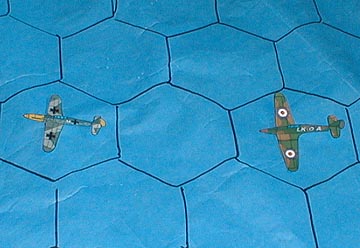 Maneuver
Cards: Each student gets
a deck of maneuver cards from which he can choose his moves for
the turn. I designed the cards in MS Word so they can be printed
on business cards. Each card names the maneuver, illustrates how
to move the plane, and describes it in words. The maneuver deck
Mic developed contains the following moves: 3 Right Turns, 3 Left
Turns, 3 Straight aheads, 3 Right Slips, 3 Left Slips, 1 Straight
Fast, 1 Immelman Turn, 2 Hard Right turns, and 2 Hard Left turns.
This is the same deck as the WW
I air combat game with the following changes: Remove the stall
maneuvers, add 2 Hard Right turns, and 2 Hard Left turns. There
is also a Straight Fast move three hexes card which may be used
(see optional rules). You can download the maneuver cards as a
MS Word file ww2mancards.doc (117
kb) or as separate gif files page1.gif
and page2.gif (print this page if you
already have the WW I cards) , page 3.gif
(Immelman Turn and Straight Fast 3 hexes for optional rules),
page 4.gif (card backs). I suggest you
write a different letter on the back of each deck so that when
the kids drop or lose cards they can be returned to the right
deck.
Maneuver
Cards: Each student gets
a deck of maneuver cards from which he can choose his moves for
the turn. I designed the cards in MS Word so they can be printed
on business cards. Each card names the maneuver, illustrates how
to move the plane, and describes it in words. The maneuver deck
Mic developed contains the following moves: 3 Right Turns, 3 Left
Turns, 3 Straight aheads, 3 Right Slips, 3 Left Slips, 1 Straight
Fast, 1 Immelman Turn, 2 Hard Right turns, and 2 Hard Left turns.
This is the same deck as the WW
I air combat game with the following changes: Remove the stall
maneuvers, add 2 Hard Right turns, and 2 Hard Left turns. There
is also a Straight Fast move three hexes card which may be used
(see optional rules). You can download the maneuver cards as a
MS Word file ww2mancards.doc (117
kb) or as separate gif files page1.gif
and page2.gif (print this page if you
already have the WW I cards) , page 3.gif
(Immelman Turn and Straight Fast 3 hexes for optional rules),
page 4.gif (card backs). I suggest you
write a different letter on the back of each deck so that when
the kids drop or lose cards they can be returned to the right
deck.
Pilot Licenses:
The pilot license is a sheet, about
the size of an index card, where the students can record the damage
to their planes and record their victories. They were designed
to resemble baseball cards, with the name and picture of a WW
II ace, his victory total, and a brief biographical blurb. The
sites used in creating the licenses are listed in the resources
section at the end of this page. The two most useful sites were
Aces of WW
II and WW
II Ace Stories. I laminated the pilot licenses so they could
be marked with dry erase markers. They should be printed in landscape
mode. You can download the pilot license cards as MS Word files:
USpilots.doc (214 kb), Germanpilots.doc
(192 kb), Sovietpilots.doc (126
kb), Japanpilots.doc (64 kb), RAFpilots.doc (188 kb) or as separate
GIF files
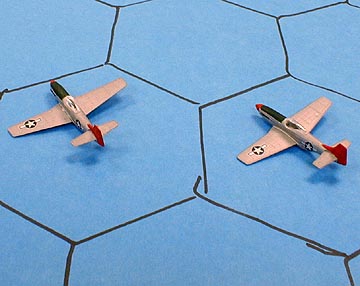 US
Page 1: Gabreski, Johnson,
MacDonald, Foss
US
Page 1: Gabreski, Johnson,
MacDonald, Foss
US Page 2: Bong, McGuire, McCampbell, Boyington
US Page 3: Preddy, Hanson, Wade, Harris
US Page 4: Meyer, Archer
German Page 1: Hartmann, Barkhorn, Rall,
Kittel
German Page 2: Nowotny, Batz, Rudorffer,
Bar
German Page 3: Graf, Juutilainen, Marseille,
Galland
Japan Page 1: Nishizawa, Iwanoto, Sugita,
Shinohara
Japan Page 2: Okumura, Anabuki, Sakai,
Sasaki
Soviet Page 1: Gulaev, Pokryshikin,
Kozhedub, Rechkalov
Soviet Page 2: Glinka, Golubev, Popkov,
Budanova
RAF page 1: Tuck, Lacey, Pattle, Malan
RAF page 2: Beurling, Caldwell, Closterman,
Johnson
RAF page 3: Finucane, Vale
Deployment: The opposing sides start on any whole
hex on opposite sides of the mat. You should line up the hex grain
so the hexes run straight across from the opposites sides, not
at an angle. Planes should be positioned so the arrow on their
base (and the nose of the plane) point at a hex side, NOT a hex
corner.
Sequence of Play:
1. Choose cards
2. Play first card and move planes
3. Resolve shooting
4. Play second card and move planes
5. Resolve shooting
6. Play third card and move planes
7. Resolve shooting
Choose Cards: At the start of the turn each pilot must
select three maneuvers from his deck of maneuver cards. Note that
there is only one card for some maneuvers so these may not be
used more than once per turn. The pilot should try to anticipate
the maneuvers of his opponents and plan accordingly. The three
cards selected should be placed face down in a stack in the order
they will be used, the rest of the cards should be set aside.
At the start of each new turn the three cards that were used are
returned to the deck and may be selected again for the new turn.
Normally everyone gest a deck with the same cards, but see the
optional rules for a different method you can try.
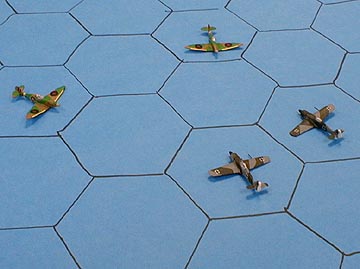 Play
Card and Move Planes:
Each turn has three rounds of movement. When all players are ready
everyone reveals their first maneuver card. Each player then moves
his plane as indicated on their card. It may be helpful at the
start to place the card next to the plane, and turn it to match
the orientation of the plane. All moves take place at the same
time. Planes should always end their move facing a hex side. This
procedure is repeated for the second and third cards after shooting
is resolved.
Play
Card and Move Planes:
Each turn has three rounds of movement. When all players are ready
everyone reveals their first maneuver card. Each player then moves
his plane as indicated on their card. It may be helpful at the
start to place the card next to the plane, and turn it to match
the orientation of the plane. All moves take place at the same
time. Planes should always end their move facing a hex side. This
procedure is repeated for the second and third cards after shooting
is resolved.
Planes in the Same Hex: Sometimes two planes will end up in the
same hex. Planes in the same hex MAY NOT shoot at each other,
they are assumed to be flying at different altitudes. Do your
best to put both planes in the hex without losing track of their
facing. The problem will resolve itself when the planes make their
next move.
Resolve Shooting: Planes may ONLY fire at enemy planes
that are in the line of hexes directly in front of their nose,
they may not fire off to the sides or at an angle. Pilots must
fire at the nearest enemy plane, and may ignore any friendly planes
that are in the line of fire. If the target is one hex away the
pilot rolls five dice, two hexes away roll four dice, and so on.
Targets six or more hexes away are out of range. Hits are scored
on rolls of 4-6. The target crosses of one circle on their pilot
license for each hit received. When a plane has taken six hits
it is shot down and removed from play, until then it may be flown
normally. All firing is assumed to take place at the same time.
|
Range |
1 |
2 |
3 |
4 |
5 |
6+ |
Hits on roll of 4-6 |
|
Dice |
5 |
4 |
3 |
2 |
1 |
0 |
Crash Landings: When a plane is shot down the pilot may
be able to survive by landing the plane safely or bailing out
with a parachute. Roll one die - on a roll of 1-4 the pilot survives,
on a roll of 5 or 6 the pilot is put out of action (either killed,
captured, or seriously wounded). If a student's pilot is put out
of action they of course lose all their victories and must start
over again with a new pilot license and airplane.
Victories: The pilot that shoots down an enemy plane
is credited with a victory. If two planes hit a target on the
turn it is shot down the victory is awarded to the player doing
the most damage. If both players inflicted equal damage they each
roll a die, high roll gets the victory (re-roll ties).
Aces: When a pilot gets 5 victories they become an ace.
Ten victories is a double ace. When a pilot becomes an ace they
get to throw one extra die each time they fire at an enemy plane.
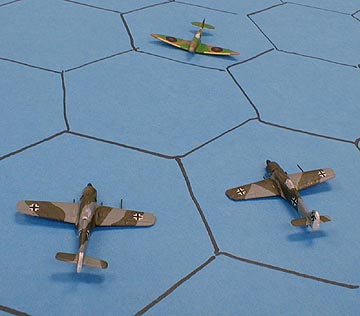 Leaving
the Board: If a pilot's
plane has received 4 or more damage points he may escape combat
by flying off the mat. If he succeeds in getting off the mat all
his damage points are restored and he may return to combat at
the start of the next turn.
Leaving
the Board: If a pilot's
plane has received 4 or more damage points he may escape combat
by flying off the mat. If he succeeds in getting off the mat all
his damage points are restored and he may return to combat at
the start of the next turn.
Returning to Combat: A pilot that has survived being shot
down or left the mat voluntarily may return to combat at the start
of the next turn. Their plane will start the turn undamaged. They
must place their plane on any whole hex on any edge of the mat
that is at least six hexes from the nearest enemy plane. This
is to prevent them from flying in right behind an opponent. The
hex where they start should be indicated to the other pilots before
they select their maneuver cards for that turn.
Duels: Occasionally two pilots will want to fight a one
on one duel to settle a grudge, or determine which is the better
pilot. Two players may declare that they are fighting a duel if
they enter the mat on the same turn and both players agree. The
two pilots will ignore the movements of all other planes on the
mat, and may only fire at each other. Likewise, the other players
must ignore the two dueling pilots, and may not shoot at them.
The duel continues until one or both planes are shot down. The
winning pilot must then fly off the mat before rejoining the dogfight.
Optional Rules: Fighter planes of WW II varied widely in terms
of speed, maneuverability, durability, and firepower. You can
use these optional rules to model these differences.
- Maneuverability: Cards can be removed or added to the
deck to model the flight characteristics of different aircraft.
Fast aircraft can be given a card that allows it to move straight
for three hexes (3ST). Other planes should have fewer Hard Right
(HR) and Hard Left (HL) turns than the average plane. The Aircraft
Data Table lists some suggested changes.
- Firepower: Some planes were better armed than others.
The Aircraft Data Table shows some suggested changes to the shooting
rules for selected aircraft.
- Damage Points: Not all planes would have the same number
of damage points. Check the Aircraft Data Table for suggested
damage points for some example aircraft.
- Special Cases: The Japanese Zero was very nimble. A
pilot flying the Zero chooses four maneuver cards instead of
three. The fourth card is used after all players have used their
third card. In addition to the changes show in the Aircraft Data
Table, the Lightning must use a straight or sideslip maneuver
before playing a right or left turn.
Aircraft Data Table (Optional)
|
Aircraft |
Remove Cards |
Add Cards |
To Hit |
Damage Points |
|
Me-109 |
* |
* |
* |
6 |
|
Me-109A |
* |
* |
3-6 @ 1Hex |
6 |
|
Me-110 |
1xHR, 1xHL |
* |
3-6 |
7 |
|
Fw-190D |
* |
3ST |
3-6 @ 1Hex |
6 |
|
Me-262 |
1xHR, 1xHL |
3ST |
3-6 @ 1Hex |
7 |
|
Me-163 |
1xHR, 1xHL |
3ST |
3-6 @ 1Hex |
7 |
|
Spitfire |
* |
3ST |
* |
6 |
|
Hurricane |
1xHR, 1xHL |
* |
* |
6 |
|
Mosquito |
1xHR, 1xHL |
* |
* |
6 |
|
Mustang |
1xHR, 1xHL |
3ST |
* |
6 |
|
Thunderbolt |
1xHR, 1xHL |
* |
* |
6 |
|
Lightning |
2xHR, 2xHL, R, L |
2x3ST |
3-6 @ 1-3 Hexes |
8 |
|
Corsair |
1xHR, 1xHL |
* |
* |
6 |
|
Zero |
* |
* |
5-6 @ 3-5 Hexes |
5 |
|
Key: * = no change,
HR= Hard Right Turn, HL = Hard Left Turn, R = Right Turn, L =
Left Turn, 3ST = Straight Fast three hexes |
< Home
>
Resources: Here are some useful resources for WW
II dogfights
 Historical
Background: At the start
of World War II some pilots were still flying obsolete bi-planes.
By the end of the war Germany had entered the jet age. The Luftwaffe
was an essential element in the early success of the German blitzkrieg.
The Battle of Britain was fought in the skies. The Allies had
to gain air superiority before they could launch the D-Day invasion.
German targets were bombed night and day. Eventually the threat
of attack from the air was a major obstacle to German operations.
In the Pacific the Japanese aircraft carriers dominated the seas.
Only after four Japanese carriers (and many veteran pilots) were
destroyed at the Battle of Midway did the United States turn the
tables. Thereafter each island captured meant a new airfield to
extend the range of US air power. The desperate Japanese resorted
to kamikaze attacks. In the end, the war was ended with atomic
bombs delivered by bombers.
Historical
Background: At the start
of World War II some pilots were still flying obsolete bi-planes.
By the end of the war Germany had entered the jet age. The Luftwaffe
was an essential element in the early success of the German blitzkrieg.
The Battle of Britain was fought in the skies. The Allies had
to gain air superiority before they could launch the D-Day invasion.
German targets were bombed night and day. Eventually the threat
of attack from the air was a major obstacle to German operations.
In the Pacific the Japanese aircraft carriers dominated the seas.
Only after four Japanese carriers (and many veteran pilots) were
destroyed at the Battle of Midway did the United States turn the
tables. Thereafter each island captured meant a new airfield to
extend the range of US air power. The desperate Japanese resorted
to kamikaze attacks. In the end, the war was ended with atomic
bombs delivered by bombers. Rules
Rules Maneuver
Cards: Each student gets
a deck of maneuver cards from which he can choose his moves for
the turn. I designed the cards in MS Word so they can be printed
on business cards. Each card names the maneuver, illustrates how
to move the plane, and describes it in words. The maneuver deck
Mic developed contains the following moves: 3 Right Turns, 3 Left
Turns, 3 Straight aheads, 3 Right Slips, 3 Left Slips, 1 Straight
Fast, 1 Immelman Turn, 2 Hard Right turns, and 2 Hard Left turns.
This is the same deck as the
Maneuver
Cards: Each student gets
a deck of maneuver cards from which he can choose his moves for
the turn. I designed the cards in MS Word so they can be printed
on business cards. Each card names the maneuver, illustrates how
to move the plane, and describes it in words. The maneuver deck
Mic developed contains the following moves: 3 Right Turns, 3 Left
Turns, 3 Straight aheads, 3 Right Slips, 3 Left Slips, 1 Straight
Fast, 1 Immelman Turn, 2 Hard Right turns, and 2 Hard Left turns.
This is the same deck as the  US
Page 1:
US
Page 1: Play
Card and Move Planes:
Each turn has three rounds of movement. When all players are ready
everyone reveals their first maneuver card. Each player then moves
his plane as indicated on their card. It may be helpful at the
start to place the card next to the plane, and turn it to match
the orientation of the plane. All moves take place at the same
time. Planes should always end their move facing a hex side. This
procedure is repeated for the second and third cards after shooting
is resolved.
Play
Card and Move Planes:
Each turn has three rounds of movement. When all players are ready
everyone reveals their first maneuver card. Each player then moves
his plane as indicated on their card. It may be helpful at the
start to place the card next to the plane, and turn it to match
the orientation of the plane. All moves take place at the same
time. Planes should always end their move facing a hex side. This
procedure is repeated for the second and third cards after shooting
is resolved. Leaving
the Board: If a pilot's
plane has received 4 or more damage points he may escape combat
by flying off the mat. If he succeeds in getting off the mat all
his damage points are restored and he may return to combat at
the start of the next turn.
Leaving
the Board: If a pilot's
plane has received 4 or more damage points he may escape combat
by flying off the mat. If he succeeds in getting off the mat all
his damage points are restored and he may return to combat at
the start of the next turn.